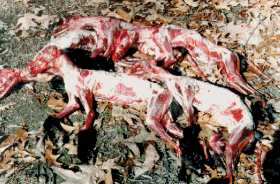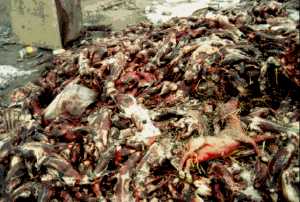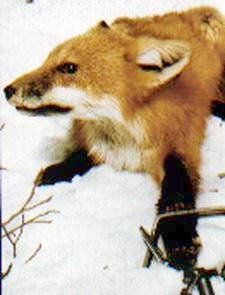THE FUR TRADE
Each year, more than 1 billion rabbits and 50 million other animals — including foxes, seals, mink, and raccoon dogs — are raised on fur farms or trapped in the wild and killed for their pelts. Because much of the fur is imported from China and other countries that have poor regulation, it is often mislabeled as "faux". Depending on the size of the garment, 100 animals or more may be killed for a single coat.
FUR FARM CONDITIONS
The vast majority of animals killed for fur are raised on farms and kept in deplorable conditions. Mink and foxes are naturally wild animals and do not adapt to life in captivity. Wild mink instinctively ranges a territory of approximately 741 acres in size. In contrast, ranch-raised mink is confined to a 12” by 18” cage. This type of intensive confinement can result in self-mutilation, cannibalism, and high-level stress that weakens the immune system and makes animals more susceptible to disease.
Approximately 30% of mink herds raised on Utah fur farms carry Aleutian disease (AD). Currently, there is no treatment, vaccine or cure for this highly infectious disease, resulting in the mortality of about 20% of the herd annually.
Another risk to life in captivity includes farmers selectively crossbreeding mink with naturally occurring mutations, which results in fur colors never seen in nature. This has led to genetic defects resulting in deaf white mink and pastel mink with nervous disorders.
Farmed foxes are raised in small outdoor cages, exposed to the harsh elements of winter and summer. Many foxes develop psychotic behavior, literally bouncing off the walls of their cages as they are pacing furiously back and forth. Many develop problems from standing on wire for months on end. In the end, they are anally electrocuted in order to preserve the fur.
Mink, which in the wild are very active animals, are raised in tiny cages, each about the length of the animal's own body. The typical mink farm is comprised of units, each with dozens of rows of individual cages with open sides that expose the animals to harsh weather. Conditions are deplorable and filthy. Farmed mink is killed by gassing, violent neck breaking or poisoning, all slow grueling deaths. Approximately 10% of animals die every year due to stress and illness.
 Discarded skinned bodies of foxes. Discarded skinned bodies of foxes. |
 A mound of discarded mink bodies. This pile represents only a few full-length coats. A mound of discarded mink bodies. This pile represents only a few full-length coats. |
TRAPPING AND HUNTING
Worldwide, there are approximately 10 million wild animals trapped and killed exclusively for their fur each year.
Leg Hold Traps

The most popular form of trapping throughout the U.S., Canada and Russia (top three wild fur pelt producers) is the leg hold trap. However, 90 countries and some states,
including California, Florida, Massachusetts, New Jersey, Rhode Island, and Washington, have banned the use of the leg hold trap because of the cruelty it inflicts on animals. It has been deemed “inhumane” by the American Veterinary Medical Association.
The steel-jaw trap violently clamps down on the animal’s leg, leaving the helpless creature to struggle for hours or days without food, water or protection from the weather and predatory animals. When the owner eventually returns to collect his “catch,” he viciously kills the animal by clubbing or suffocating the animal by standing on its neck and chest for several minutes, ensuring that the pelt is not damaged.
Drowning Sets
Trappers have designed this device to drown and kill semi-aquatic animals like mink, beavers, and muskrats. As the animals try to swim to safety, they are drowned by the weight of this leg hold trap. Mink can struggle for up to four minutes, muskrats for five minutes, and beavers for 15 minutes before drowning.
Conibear Traps
This vertical trap, designed by Frank Conibear in 1958, is an “instant-kill” device that breaks the neck of its intended victim. The major problem is that the trap does not discriminate. It may do its job on the animal it’s designed for but causes slow painful suffering to the wrong sized animal or the wrong species.
However, the British Columbia Research Council proved the idea of an “instant kill” trap to be false. They discovered it takes up to three minutes to kill 90% of the animals.
Trapping Risks
In some cases, animals will try to free themselves at any cost, including knocking out their teeth as they bite on the steel trap and chewing off their own feet. In fact, it is estimated that one in every four animals trapped will succeed in amputating a limb to survive.
Many sources indicate between one and ten “non-target” animals are caught in traps for every single target animal. Non-target animals include golden eagles, antelope, domestic livestock, birds, rabbits, deer, porcupines, and domestic dogs and cats. These animals are considered “trash” by the merciless fur trappers and discarded.
SEALS KILLED FOR FUR
 Fur sealEach year from November through March, harp seals migrate from Greenland to Canada’s Atlantic coast. This annual cycle of birth and renewal is tainted by a Canadian government-sanctioned hunt, which encourages the slaughter of a large number of seals.
Fur sealEach year from November through March, harp seals migrate from Greenland to Canada’s Atlantic coast. This annual cycle of birth and renewal is tainted by a Canadian government-sanctioned hunt, which encourages the slaughter of a large number of seals.
The Canadian government and animal advocates are at the center of this heated debate. Under the reign of former Prime Minister Chrétien, the Canadian government increased its kill quota by 25% which could result in the slaughter of almost one million seals during the next three migration seasons. The government claims the overpopulation of seals has depleted cod fisheries. In reality, the exorbitant number of seals murdered in the 1960s depleted the seal population to a meager 1.8 million. Today, the seal population has returned to a normal 5.2 million.
In 2016, over 66,000 seal pups were killed for their fur, genitalia, and Omega 3 oils. The fur is used to make clothing, boots and garment trim; genitals are widely used as an aphrodisiac in traditional Chinese medicine, and the oils are used as a supplement for human consumption. The majority of the seals are skinned alive and are between the ages of 12 days and 12 months old. Others are left to suffer after being clubbed until a hunter returns to skin them.
THE FUR FASHION INDUSTRY
Millions of dogs and cats in China are bludgeoned, hanged, bled to death, and strangled with wire nooses so that their fur can be turned into trim and trinkets. This fur is often deliberately mislabeled as fur from other species and is exported world-wide to be sold to unsuspecting customers in retail stores.
However, there are many designers who refuse to work with animal fur such as Stella McCartney and Todd Oldham, two of today’s most fashionable designers, who are dedicated to only using synthetic materials in their designs. Furthermore, it is gratifying to know luxurious alternatives to animal fur exist and, at the same time, make the destruction of countless animals unnecessary.
Priscilla Presley Speaks Out Against Fur
LEARN ABOUT CHINA'S DOG AND CAT FUR TRADE












